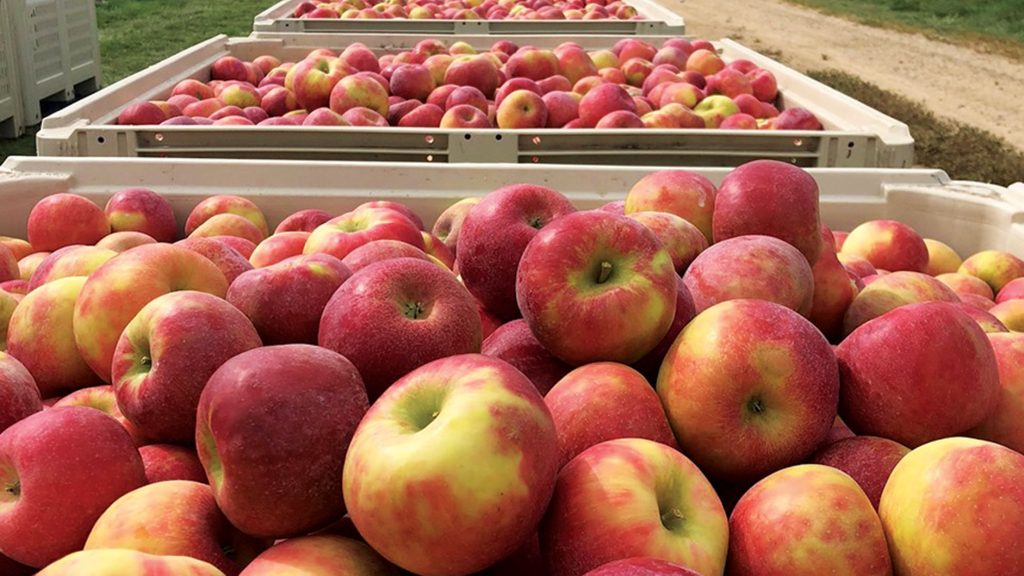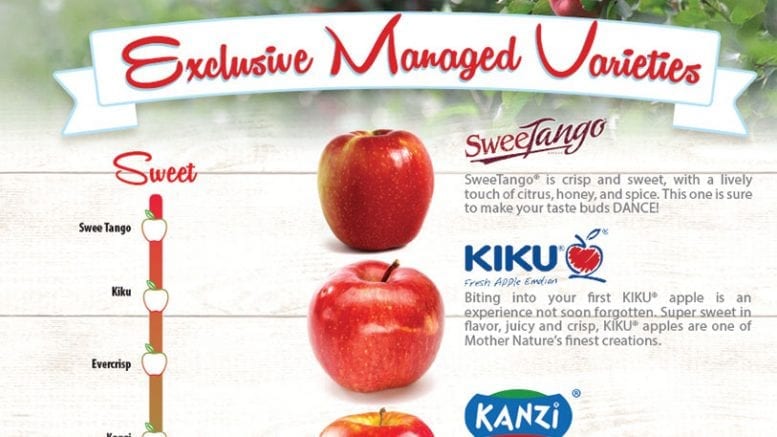‘A CELEBRATION IN YOUR MOUTH’
September 1, 2019 | 8 min to read
The article highlights the exceptional quality of Michigan apples, particularly the Honeycrisp, due to the region's unique microclimate created by the Great Lakes. Local growers emphasize that consuming these apples offers a delightful sensory experience. As the third largest apple-producing state, Michigan's harvest for 2019 is projected to be strong. The Michigan Apple Committee works to promote local branding, appealing to consumers' desire for fresh, locally-grown produce while expanding distribution across 32 states and 18 countries.

The local difference means more than just fewer miles to market.
The moderating influence of the Great Lakes creates a microclimate that is about as good as it gets for ripening Honeycrisp, Gala and Fuji apples.
“Michigan apples are grown on the west side of the state, near Lake Michigan,” says Trish Taylor, account manager for River Ridge Produce Marketing, Sparta, MI. “It gives them cool nights, hot days and good soil for growing apples.”
The locals have an affection for these apples that runs deeper than a desire for the fruit grown by the farmer next door, or just down the road.
“Biting into a Michigan apple is more than eating a piece of fruit,” says Antonia Mascari, vice president of marketing at Applewood Fresh, Sparta, MI. “It’s … the color you expect, the firmness in your hand, the crunch between your teeth, the celebration in your mouth.”
These great-tasting apples are valued as local throughout much of the Midwest, and the Michigan Apple brand travels throughout the Western Hemisphere.
Above all else, the locals will tell you, it is hard to beat a Honeycrisp apple as grown under the climatic influence of Lake Michigan.
“We really promote the Honeycrisp, both in bulk and in tote bags,” says Jim Weber, produce director at Brillion, WI-based Tadych’s Markets, an independent chain with six full-service supermarkets in Michigan and Wisconsin. “We run ads for both bulk and tote bags of Honeycrisp from Michigan.”
A Good Harvest Year
The size of the harvest depends on a number of weather factors, and all signs indicate 2019 will be a good year.
“Growers are feeling quite optimistic about the 2019 crop,” says Diane Smith, executive director of the Michigan Apple Committee, Lansing, MI.
Michigan is the third largest apple producing state, according to US Department of Agriculture statistics, at a smidge more than 25 million bushels a year. The harvest rebounded last year from a rough 2017 to approach the record of 1.28 billion pounds, which was set in 2016.
“There are many factors that can cause slight changes in crop size over the years,” says Smith. “Extreme cold, spring frosts, summer storms, as well as various pests and diseases, can cause damage in orchards. On the other side of that coin, as growers continue to plant in high-density blocks and adopt new growing technologies, it will be possible to see increases in crop size into the future.”
According to the Apple Committee, the harvest begins with the Paula Reds and the Ginger Golds in late August. Harvesting continues all the way through the Romes, Ida Reds, and Braeburns into October.
Applewood Fresh co-owner Scott Swindeman expects the company’s overall volume to be up 10% this year.
Another large shipper also expects to see good volumes, in particular — the prized Honeycrisp variety from Michigan orchards.
“We are expecting a huge shift forward in volume,” says Angela Sommers, marketing director at BelleHarvest, Belding, MI. “We now are estimated to have nearly three million cartons of packed fruit for the upcoming season. Honeycrisp volume throughout the state is down this year, however, we are thrilled to see that several of our growers were able to set a nice crop.”
BelleHarvest ships throughout the Western Hemisphere in addition to serving the strong local market.
“Our fruit has traveled down to Central and South America, along with Israel,” says Sommers. “We do mostly domestic sales, but we have certainly done a lot of export.”
The Michigan apple brand travels throughout most of the United States and a considerable part of the world.
“Michigan apples are sold in 32 states and 18 countries,” notes Smith. “Michigan apples are exported all over the world, including countries in Central and South America, as well as Asia.”
A Local Brand That Travels Well
Although the brand travels, Michigan apples are treasured most by consumers within the state or the neighboring Midwest area.
“Michigan apples have been at the forefront of the local movement,” says Brian Coates, vice president of sales at Applewood Fresh. “The movement toward more local produce across the produce department helps with selling Michigan apples by drawing more attention to regionally grown apples. Local apple sales continue to grow. Applewood Fresh ships in the Midwest to Iowa, Minnesota, Missouri, and Kansas, south to Texas, Georgia and Florida, and exports a small percentage of the crop. Folks want to know where the apples are grown,” says Taylor. “We use a seal that says they are from Michigan. We sell them primarily east of the Mississippi.”
The growers near the shores of the Great Lakes are well situated to market their fruit as local to a huge portion of the country’s population.
“Consumer data continues to show shoppers prefer locally grown produce,” says Smith, of the Michigan Apple Committee. “With half of the U.S. population within 500 miles of Michigan, the concept of locally grown works very well for us. As the third largest producer of apples in the nation, we can serve that population with locally grown, high quality fruit.”
Geography positions Michigan growers to be able to serve most of their customers with apples that are fresher than the competition.
“Michigan apples log fewer miles than Washington and New York apples,” says Applewood Fresh’s Mascari. “That is excellence in sustainability. We respect and value the natural resources that enable us to deliver the world’s best apples to you. Taste the locally grown difference. Local means fresh, and reduces the carbon footprint.”
The combination of proximity to the markets and the beneficial influence of the microclimate from the lake make these apples a quality eating experience.
“It’s a mind blowing, crunch packed, juice a licious experience,” says Mascari.
Honeycrisp And A Few Friends
Honeycrisp, which can only be grown near the shores of Lake Michigan, is widely popular.
“Michigan can grow an exceptional Honeycrisp,” says Sommers. “The flavor profile is outstanding, while the color is superior.”
Michigan Honeycrisp, Fuji, Gala and Jonagold are consistently ranked highly, according to Swindeman from Applewood Fresh, but Weber from Tadych’s is developing a new favorite.
“Another apple from BelleHarvest we really like is the Topaz,” he says. “The flavor is the opposite of Honeycrisp; it’s really tart, but it’s a good tart.”
Growers are constantly experimenting, however, in order to add new and exciting varieties to the mix.
“The newest variety expected to catapult Applewood Fresh’s reputation for excellence is Rave,” notes Swindeman. “We’ve grown the juicy, early season Honeycrisp-meets-MonArk cross as a test for the past three years. An agreement has been signed with Stemilt, a family-owned fruit tree growing, packing and shipping company based in Wenatchee, WA, to plant significant acreage of the variety in two locations in Michigan. More Kanzi and Evercrisp are available because of an increase in production of young orchards.”
Other major shippers are also constantly looking at new varieties.
“We are constantly working together to produce the very finest apples — our growers, Applewood Fresh and our valued customers,” says Mascari. “We are always looking for new varieties to plant. We have strict standards so only the best quality apples come to fruition.”
The top three have been constant for a while, but the complementary varieties can be shifting.
“Michigan growers try to stay competitive with their varietal mix to keep up with consumer and retail demand,” notes Smith. “This means we’ll likely see varieties like Rome and Jonathan reduced in production to make room for more Honeycrisp, Gala, and Fuji, as well as some managed varieties that are grown here in our state.”
MICHIGAN GROWN: LOCAL IS FRESHER
Promoting this fruit as local and fresh is the linchpin to a successful merchandising program.
“We have signs in our stores in both Michigan and Wisconsin that say ‘support the local apples,’” says Jim Weber, produce director at Brillion, WI-based Tadych’s Markets, an independent chain with six full-service supermarkets in Michigan and Wisconsin.

“We’ll display them next to the caramel apples, and sometimes we’ll have some recipes.”
The peak time for Michigan apple promotion at the Tadych’s stores is the beginning of October.
“Leverage the power of local,” advises Angela Sommers, marketing director at BelleHarvest, Belding, MI. “If we want to have a successful Honeycrisp program, we need to provide the right packaging for every budget. Consumers know the ‘Honeycrisp’ name, and it’s important that we stay consistent with flavor and quality. We also need to carefully consider all the varieties we are offering to consumers because it’s causing confusion at retail.”
Because the brand matters, it is helpful to maintain the supply of Michigan apples over as long a season as possible.
“It’s critical that we keep our local stores supplied with Michigan fruit as long as can,” says Sommers. “The benefits to a retailer, from a freight perspective, are far greater than bringing fruit in from the East or West Coast.”
Shippers help to connect consumers with the Michigan apple growers and their delicious product.
“Our team at Applewood Fresh is constantly updating marketing programs to help propel apple sales,” says Antonia Mascari, vice president of marketing at Applewood Fresh, Sparta, MI. “It’s not just a one-size-fits-all approach; we tailor programs to fit each customer’s needs. To increase sales, retailers need to create large, eye-catching apple displays. It’s important to have signage for each apple — whether it’s an info card with nutrition, creative uses, or the origin of the apple or meet the grower at the point of sale.”
Another important source of promotional help is the Michigan Apple Committee, which gets high marks in this regard from the shippers.
“The committee does a great job of supporting the Michigan apple growers,” says Sommers. “They are working hard each day to ensure that a Michigan apple is in the right place at the right time. The marketing programs they promote are effective and help increase consumption each year. They are always pushing new and innovative ways to reach the retailer and consumer.”
The committee is always looking for original ways to emphasize the geographic origin of the fruit.
“Marketing the fruit with its origin is important to us,” says Diane Smith, executive director of the Michigan Apple Committee, Lansing, MI.
“Consumers are loyal to Michigan-grown apples, and we feel it is important for them to be informed about where their fruit comes from. We want to help them find Michigan apples.” These consumers are loyal first and foremost to fruit that tastes great, and fruit that has a good mouth feel.
36 of 37 article in Produce Business September 2019

